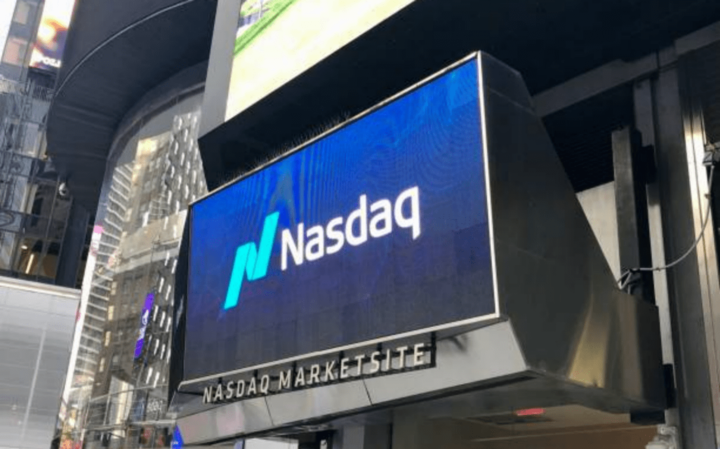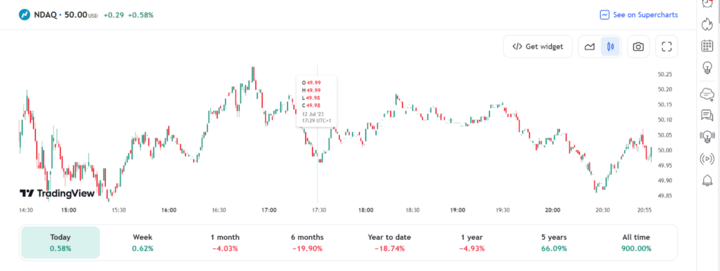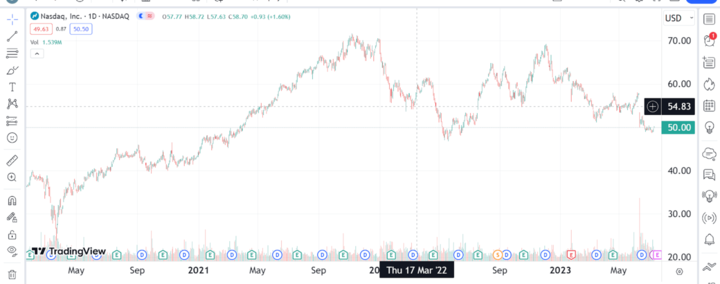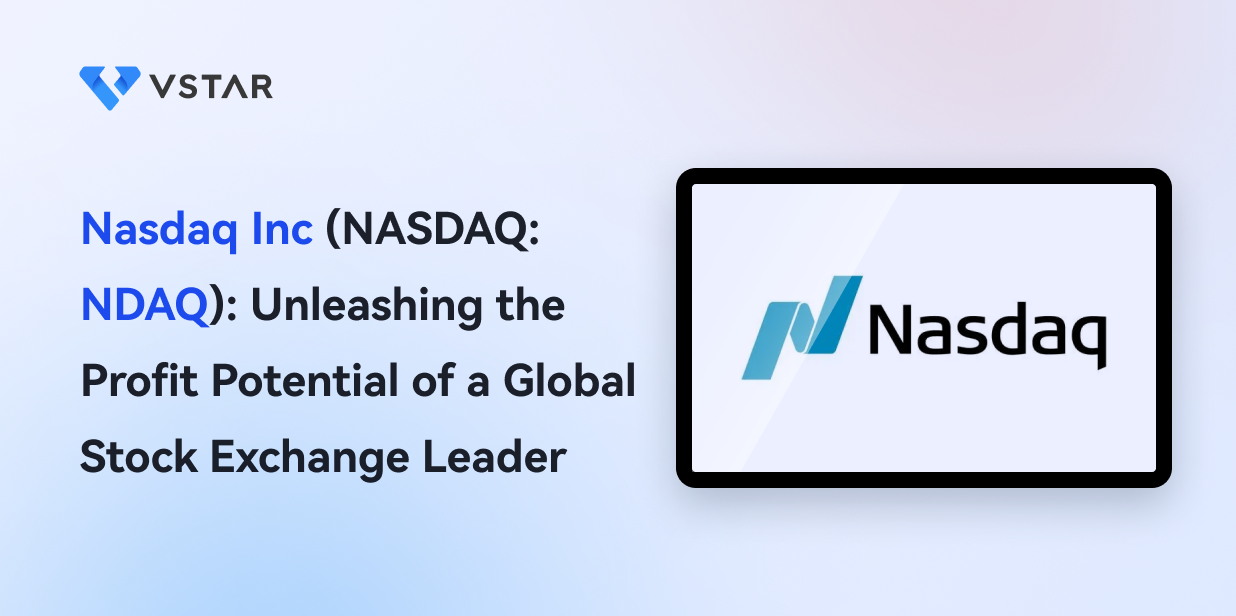Nasdaq, Inc. (Nasdaq: NDAQ) has been making headlines lately with a number of significant announcements. In June, the company acquired Adenza, a leading provider of cloud-based trading technology. The acquisition is part of Nasdaq's strategy to accelerate its transformation into a leading technology provider for the global financial system.
In July, Nasdaq announced a 10% increase in its quarterly dividend to $0.22 per share. The dividend is payable on June 30, 2023. The company also announced the election of all nominated directors to the boards of its U.S. exchanges. Now, let’s get into something deeper.
I. Nasdaq Inc's Overview
Nasdaq Inc, founded in 1971 by the National Association of Securities Dealers (NASD) and led by founder Arthur Levitt, Sr., is headquartered in New York City.
Adena Friedman is the CEO of Nasdaq Inc. Friedman, who joined the company in 1993, has a long history with Nasdaq, having served in a variety of leadership roles before assuming the role of CEO. Her extensive experience in the financial industry and deep understanding of Nasdaq's operations have been instrumental in driving the company's strategic initiatives.
When it comes to top shareholders, Nasdaq Inc. counts The Vanguard Group, BlackRock, State Street Corporation, Morgan Stanley, and Fidelity Investments among its key investors. These renowned financial institutions demonstrate their confidence in Nasdaq's business and contribute to the company's growth and stability.
Throughout its history, Nasdaq Inc. has achieved several significant milestones. In 1971, it launched the NASD Automated Quotations (NASDAQ) system, introducing an innovative approach to stock trading. In 1985, the NASDAQ Stock Market became a fully electronic exchange, revolutionizing the way securities are traded.
In 1993, Nasdaq introduced the Nasdaq Composite Index, providing a comprehensive view of the stock market. Mergers and acquisitions have also played a role in Nasdaq's growth, including the merger with Nordic Exchange Group in 2005 and the acquisition of OMX Group in 2013. In 2022, Nasdaq launched the Nasdaq Private Market, an innovative platform that facilitates the trading of private securities.
II. Nasdaq Inc's Business Model and Products/Services
Image Source: Istock
A. How Nasdaq Inc. makes money
- Listing fees: Companies that choose to list their securities on Nasdaq pay a one-time listing fee and annual maintenance fees.
- Trading fees: Nasdaq charges a fee for each trade executed on its exchange.
- Data fees: Nasdaq generates revenue by selling market data to financial institutions and other market participants.
- Technology fees: Nasdaq charges fees for the use of its trading and clearing technology.
B. Main Products and Services
- Market Services: Nasdaq provides trading and clearing services for equities, options, and fixed income securities.
- Information Services: Nasdaq offers market data, analytics, and compliance solutions.
- Corporate Solutions: Nasdaq provides listing, governance, and technology services to companies.
- Technology Solutions: Nasdaq offers trading, clearing, and market data technology solutions to exchanges and other financial institutions.
In addition to these core products and services, Nasdaq Inc. has expanded its offerings with the following:
- Nasdaq Private Market: A platform that facilitates the trading of private securities, providing liquidity and access to private investment opportunities.
- Nasdaq Linq: A blockchain-based platform designed for trading and managing securities, enabling more efficient and secure transactions.
- Nasdaq Iceland: A stock exchange based in Iceland, facilitating the trading of Icelandic securities.
- Nasdaq Baltics: A group of stock exchanges located in the Baltic region, comprising exchanges in Estonia, Latvia, and Lithuania. These exchanges provide a platform for trading Baltic securities.
III. Nasdaq Inc's Financials, Growth, and Valuation Metrics
A. Review of Nasdaq Inc's financial statements
Market Capitalization: As of July 12, 2023, Nasdaq Inc.'s market capitalization stands at $24.39 billion. This represents the total value of the company's outstanding shares in the stock market.
Net Income: In 2022, Nasdaq Inc. reported net income of $1.14 billion. This figure indicates the profitability of the company after deducting all expenses, taxes, and interest.
Revenue Growth: Over the past five years, Nasdaq Inc.'s revenue has grown from $4.2 billion in 2018 to $6.2 billion in 2022. This represents a CAGR of 9.5%.
Profit Margins: Nasdaq Inc.'s gross margin has averaged 57.5% over the past five years. This means that for every $100 in revenue, the company generates $57.50 in gross profit. Nasdaq Inc.'s operating margin has averaged 25.1% over the past five years. This means that for every $100 in revenue, the company generates $25.10 in operating profit.
Return on Equity: Nasdaq Inc.'s ROE has averaged 17.93% over the past five years. This means that for every $100 in shareholders' equity, the company generates $17.93 in profit.
Balance Sheet Strength and Implications: Nasdaq Inc.'s balance sheet shows strength with a current ratio of 1.10, indicating the company's ability to meet its short-term obligations. Additionally, the debt-to-equity ratio of 0.16 suggests that Nasdaq Inc. has a conservative capital structure with less reliance on debt financing.
B. Key financial ratios and metrics
To assess Nasdaq Inc.'s valuation, we can consider several important metrics and compare them to its peers and the industry:
P/E Ratio: Nasdaq Inc.'s P/E ratio is 21.56, which is slightly higher than the average P/E ratio for the S&P 500. This implies that investors are willing to pay a slightly higher price for each dollar of earnings generated by the company, potentially indicating positive market sentiment.
P/S Ratio: With a P/S ratio of 4.91, Nasdaq Inc.'s valuation based on revenue is below the average P/S ratio for the S&P 500. This suggests that the market values Nasdaq Inc.'s revenue lower than its peers, potentially indicating an undervalued stock.
P/B Ratio: Nasdaq Inc.'s P/B ratio is 4.90, also below the average P/B ratio for the S&P 500. This implies that the market values Nasdaq Inc.'s book value lower than its peers, which could indicate an undervalued stock.
EV/EBITDA Ratio: Nasdaq Inc.'s EV/EBITDA ratio of 15.20 is slightly below the average EV/EBITDA ratio for the S&P 500. This metric measures the company's valuation relative to its earnings before interest, taxes, depreciation, and amortization. A lower ratio may suggest a potentially undervalued stock.
Based on the financial metrics, Nasdaq Inc. appears to be fairly valued. The company has strong revenue growth, profit margins, and return on equity. However, the stock is neither significantly undervalued nor overvalued at its current price.

Image Source: Istock
IV. NDAQ Stock Performance
A. NDAQ Stock trading information
IPO Time: Nasdaq Inc. went public on February 9, 1971.
Primary exchange & Ticker: Nasdaq Inc.'s primary exchange is the Nasdaq Stock Market, and its ticker symbol is NDAQ.
Country & Currency: Nasdaq Inc. is headquartered in the United States, and its stock is traded in U.S. dollars.
Trading hours: Nasdaq Inc.'s stock trades from 9:30 AM to 4:00 PM Eastern Time, Monday through Friday.
Pre-market: Nasdaq Inc.'s stock trades in the pre-market from 4:00 AM to 9:30 AM Eastern Time.
After-market: Nasdaq Inc.'s stock trades in the after-market from 4:00 PM to 8:00 PM Eastern Time.
NDAQ Stock splits: Nasdaq Inc. has undergone 10 stock splits since its IPO, which have adjusted the number of shares outstanding.
NDAQ Stock Dividends: Nasdaq Inc. has consistently paid dividends since 1993. The current dividend yield is 1.80%.
B. NDAQ Stock Price Performance since its IPO

Historical Highs and Lows: Nasdaq Inc. stock has reached its all-time high of $69.22 per share and its all-time low of $48.65 per share.
Current Stock Price: As of the last update, Nasdaq Inc. stock is trading at $49.71 per share.
NDAQ Stock Price Volatility Analysis: Nasdaq Inc.'s stock has shown volatility over time, with a standard deviation of 18.6%. This indicates fluctuations in the stock's price movement.
Key Drivers of NDAQ Stock Price
The overall performance of the global financial markets is a significant driver of Nasdaq Inc.'s stock price. As a major stock exchange operator, Nasdaq's fortunes are closely tied to the broader market conditions. Positive market trends, such as increased investor confidence, economic growth, and strong corporate earnings, can have a positive impact on Nasdaq's stock price.
The growth of the digital economy is another crucial driver. Nasdaq Inc. plays a key role in facilitating the listing and trading of technology companies and other firms driving digital transformation. As the digital economy expands, the demand for technology-related services, data analytics, and digital solutions offered by Nasdaq can positively impact its stock price.
In addition, Nasdaq's ability to innovate and adopt new technologies is a key driver. The company's success in developing and implementing cutting-edge trading and data technologies, such as blockchain and artificial intelligence, can enhance its competitive advantage and attract market participants. Investors often value companies that demonstrate a commitment to innovation and staying ahead of industry trends.
C. NDAQ Stock Forecast

Image Source: Istock
NDAQ Stock Price Trend Analysis: Nasdaq Inc.'s stock price has shown an upward trend over the past few years. It has consistently traded above its 200-day moving averages and its 50-day moving average, indicating positive momentum in its performance.
Analyst Recommendations and Price Targets: Analysts have provided recommendations and price targets for Nasdaq Inc.'s stock. The consensus analyst recommendation for the stock is "Moderate Buy." Among the analysts covering the stock, 5 analysts have a "Buy" rating, 8 analysts have a "Hold" rating, and 1 analyst has a "Sell" rating.
Price targets from major analysts vary. The highest price target for Nasdaq Inc's stock is $69.22, implying a potential upside of 38.9% from the current stock price. The lowest price target is $56.00, suggesting a potential downside of 6.2%. These price targets provide insights into the varying perspectives on the stock's future performance and potential investment opportunities.
V. Challenges and Opportunities
A. Competitive Risks

Image Source: Istock
Main Competitors
Nasdaq Inc. faces competition from other financial exchanges and data industry players such as Coinbase Global Inc. (COIN), CME Group Inc. (CME), and S&P Global Inc. (SPGI).
Coinbase Global Inc. (COIN) is one of the leading cryptocurrency exchanges. COIN is a relatively new company, but it has grown rapidly in recent years. COIN's main threat to Nasdaq Inc. is its focus on cryptocurrency trading. Nasdaq Inc. does not currently offer cryptocurrency trading, but it could be a major growth opportunity in the future.
CME Group Inc. is another leading futures exchange. CME is a well-established company with a strong track record. CME's main threat to Nasdaq Inc. is its focus on derivatives trading. Although Nasdaq Inc. does not currently offer derivatives trading, it may do so in the near future.
Competitive advantages of Nasdaq Inc.
Nasdaq Inc. has a number of competitive advantages, including:
- A strong brand: Nasdaq Inc. is a well-known and respected brand in the financial industry. This gives the company a competitive advantage over newer entrants.
- A diversified business: Nasdaq Inc. operates a number of different businesses, including market services, information services, corporate solutions, and technology solutions. This diversification helps to reduce the company's risk.
- A focus on innovation: Nasdaq Inc. is constantly investing in innovation. This helps the company to stay ahead of the curve and to develop new products and services.
B. Other Risks
- Regulatory risks: The financial exchanges and data industry is subject to extensive regulations, and changes in regulations can impact Nasdaq Inc.'s operations and compliance costs.
- Economic risks: Nasdaq Inc.'s performance is influenced by global economic conditions, including market volatility, economic downturns, and geopolitical events.
- Cybersecurity risks: Nasdaq Inc. is exposed to the risk of cyberattacks that could result in data breaches, service disruptions, reputational damage, and financial losses.
C. Growth Opportunities

Image Source: Istock
- The growth of the global financial markets: Nasdaq Inc. can benefit from the overall growth of financial markets worldwide, as increased market activity and participation can drive its trading volumes and revenues.
- Electronic trading: The growing popularity of electronic trading presents an opportunity for Nasdaq Inc., given its expertise and market position in providing electronic trading services.
- Data analytics: The increasing importance of data analytics in the financial industry provides Nasdaq Inc. with growth potential, as it is a leading provider of data analytics services that can help market participants derive insights and make informed decisions.
D. Future Outlook and Expansion
- Acquiring new businesses: Nasdaq Inc. can continue to pursue strategic acquisitions to expand its business and offerings, as demonstrated by its past acquisitions like the Nasdaq Private Market and Nasdaq Nordic Exchange.
- Expanding into new markets: Nasdaq Inc. can explore opportunities to expand its presence in emerging markets, such as China and India, where there is a growing demand for financial services.
- Investing in innovation: Nasdaq Inc. can continue to invest in innovative technologies, such as blockchain and artificial intelligence, to drive its future growth and maintain its competitive edge in the industry.
VI. Why Traders Should Consider NDAQ Stock
A. Reasons Why Traders Should Consider NDAQ Stock
Nasdaq Inc., the company behind NDAQ stock, offers several compelling reasons for traders to consider investing in its stock. Here are some key points:
Strong fundamentals: Nasdaq Inc. is known for its strong management and track record. With a diversified business model and a focus on innovation, the company has consistently delivered solid financial performance and demonstrated market resilience.
Growth potential: The global financial markets are expected to continue to grow for the foreseeable future. This provides opportunities for Nasdaq Inc. to expand its business and benefit from increased market activity and trading volumes.
Technical support: NDAQ stock has shown strong technical support around the $45.00 level in the past. Repeated holding of this level indicates a potential buying opportunity for traders looking to enter the stock on the cheap.
Relatively low volatility: Compared to more volatile stocks, NDAQ stock is considered relatively stable. This lower volatility can be attractive to traders seeking a more consistent and predictable investment option.
B. Technical Levels to Watch on NDAQ Stock

Understanding the technical levels of NDAQ stock can help traders make informed decisions. Here are some key levels and moving averages to monitor:
Key resistance level: $55.00
Key support level: $45.00
Moving averages: The 50-day moving average is currently at $49.50, while the 200-day moving average stands at $51.50.
C. Trading Strategies for NDAQ Stock
Traders can employ various strategies when considering NDAQ stock. Here are a few examples:
Buying the dip: If NDAQ stock experiences a pullback towards the key support level of $45.00, traders could consider buying the stock at that point, anticipating a potential rebound in price.
Trading the moving averages: When the 50-day moving average crosses above the 200-day moving average, it could signal a bullish trend reversal. Traders may consider entering long positions based on this technical crossover.
CFD Trading: Contract for Difference (CFD) trading is a popular method that allows traders to speculate on the price movement of NDAQ stock without owning the underlying shares. CFD trading offers advantages such as leverage, the ability to trade in both rising and falling markets, and flexibility in position sizing.
VII. Trade NDAQ Stock CFD with VSTAR
When considering trading NDAQ stock Contracts for Difference (CFDs), VSTAR is a reputable online broker that offers several advantages and features for traders. Here's why you might choose VSTAR:
Advantages of VSTAR
Competitive Costs: VSTAR provides institutional-level pricing for all traders, ensuring that you have access to competitive spreads and trading costs.
Global Assets: VSTAR offers a diverse range of trading instruments, including forex, metals, commodities, stocks, digital currencies, and indices. This allows you to explore various market opportunities and diversify your trading portfolio.
Easy Signup: VSTAR has a user-friendly and streamlined signup process, allowing you to start trading in less than 5 minutes. This quick and efficient onboarding process enables you to get into the market promptly.
Trading Education: VSTAR provides valuable educational resources, including market analysis, insights, podcast and more. These resources can help you enhance your trading knowledge and make informed trading decisions.
Comprehensive Trading Tools: VSTAR offers a wide range of trading tools to support your trading activities. These tools include advanced charting features, technical analysis indicators, and real-time market data, empowering you to conduct thorough market analysis.


VIII. Conclusion
Nasdaq Inc. is a well-established and reputable company in the financial industry, with a strong track record and a focus on innovation. Its diversified business model, coupled with its ability to adapt to market changes, positions the company for future growth. Nasdaq Inc.'s key milestones, such as the launch of the NASDAQ system, the creation of the Nasdaq Composite Index, and strategic acquisitions, demonstrate its commitment to expanding its offerings and staying at the forefront of the industry.
The company's financial statements reflect its solid performance, with consistent revenue growth, strong profit margins, and a healthy balance sheet. Nasdaq Inc.'s market capitalization and net income underscore its position as a valuable player in the market. Moreover, its top shareholders, including prominent financial institutions, highlight the confidence and trust that investors have in the company.



















